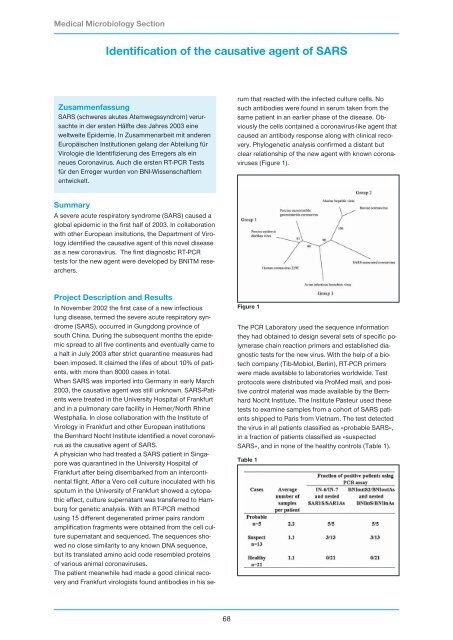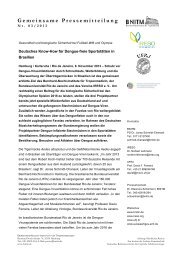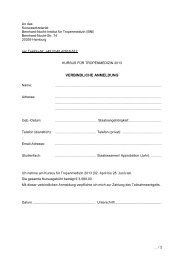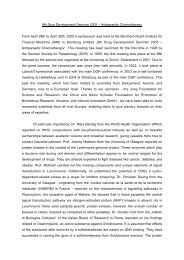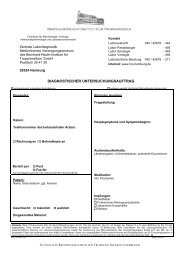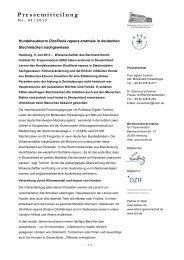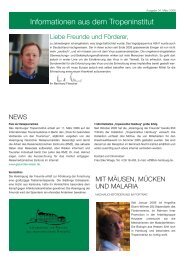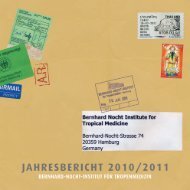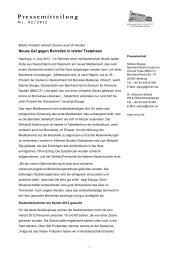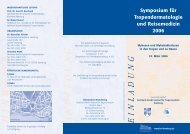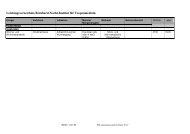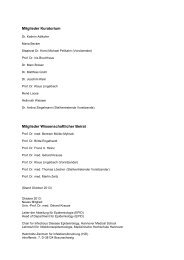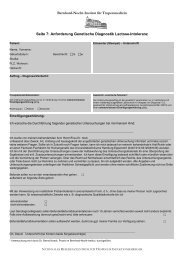Research Group Heussler (Malaria I) - Bernhard-Nocht-Institut für ...
Research Group Heussler (Malaria I) - Bernhard-Nocht-Institut für ...
Research Group Heussler (Malaria I) - Bernhard-Nocht-Institut für ...
You also want an ePaper? Increase the reach of your titles
YUMPU automatically turns print PDFs into web optimized ePapers that Google loves.
Medical Microbiology Section<br />
Identification of the causative agent of SARS<br />
Zusammenfassung<br />
SARS (schweres akutes Atemwegssyndrom) verursachte<br />
in der ersten Hälfte des Jahres 2003 eine<br />
weltweite Epidemie. In Zusammenarbeit mit anderen<br />
Europäischen <strong>Institut</strong>ionen gelang der Abteilung <strong>für</strong><br />
Virologie die Identifizierung des Erregers als ein<br />
neues Coronavirus. Auch die ersten RT-PCR Tests<br />
<strong>für</strong> den Erreger wurden von BNI-Wissenschaftlern<br />
entwickelt.<br />
Summary<br />
A severe acute respiratory syndrome (SARS) caused a<br />
global epidemic in the first half of 2003. In collaboration<br />
with other European insitutions, the Department of Virology<br />
identified the causative agent of this novel disease<br />
as a new coronavirus. The first diagnostic RT-PCR<br />
tests for the new agent were developed by BNITM researchers.<br />
Project Description and Results<br />
In November 2002 the first case of a new infectious<br />
lung disease, termed the severe acute respiratory syndrome<br />
(SARS), occurred in Gungdong province of<br />
south China. During the subsequent months the epidemic<br />
spread to all five continents and eventually came to<br />
a halt in July 2003 after strict quarantine measures had<br />
been imposed. It claimed the lifes of about 10% of patients,<br />
with more than 8000 cases in total.<br />
When SARS was imported into Germany in early March<br />
2003, the causative agent was still unknown. SARS-Patients<br />
were treated in the University Hospital of Frankfurt<br />
and in a pulmonary care facility in Hemer/North Rhine<br />
Westphalia. In close collaboration with the <strong>Institut</strong>e of<br />
Virology in Frankfurt and other European institutions<br />
the <strong>Bernhard</strong> <strong>Nocht</strong> <strong>Institut</strong>e identified a novel coronavirus<br />
as the causative agent of SARS.<br />
A physician who had treated a SARS patient in Singapore<br />
was quarantined in the University Hospital of<br />
Frankfurt after being disembarked from an intercontinental<br />
flight. After a Vero cell culture inoculated with his<br />
sputum in the University of Frankfurt showed a cytopathic<br />
effect, culture supernatant was transferred to Hamburg<br />
for genetic analysis. With an RT-PCR method<br />
using 15 different degenerated primer pairs random<br />
amplification fragments were obtained from the cell culture<br />
supernatant and sequenced. The sequences showed<br />
no close similarity to any known DNA sequence,<br />
but its translated amino acid code resembled proteins<br />
of various animal coronaviruses.<br />
The patient meanwhile had made a good clinical recovery<br />
and Frankfurt virologists found antibodies in his se-<br />
68<br />
rum that reacted with the infected culture cells. No<br />
such antibodies were found in serum taken from the<br />
same patient in an earlier phase of the disease. Obviously<br />
the cells contained a coronavirus-like agent that<br />
caused an antibody response along with clinical recovery.<br />
Phylogenetic analysis confirmed a distant but<br />
clear relationship of the new agent with known coronaviruses<br />
(Figure 1).<br />
Figure 1<br />
The PCR Laboratory used the sequence information<br />
they had obtained to design several sets of specific polymerase<br />
chain reaction primers and established diagnostic<br />
tests for the new virus. With the help of a biotech<br />
company (Tib-Mobiol, Berlin), RT-PCR primers<br />
were made available to laboratories worldwide. Test<br />
protocols were distributed via ProMed mail, and positive<br />
control material was made available by the <strong>Bernhard</strong><br />
<strong>Nocht</strong> <strong>Institut</strong>e. The <strong>Institut</strong>e Pasteur used these<br />
tests to examine samples from a cohort of SARS patients<br />
shipped to Paris from Vietnam. The test detected<br />
the virus in all patients classified as »probable SARS«,<br />
in a fraction of patients classified as »suspected<br />
SARS«, and in none of the healthy controls (Table 1).<br />
Table 1


